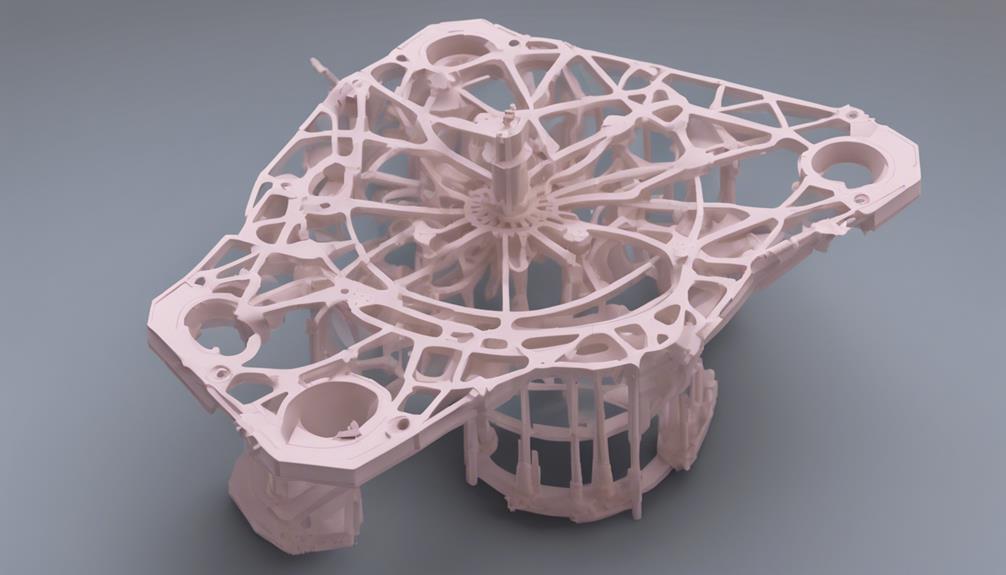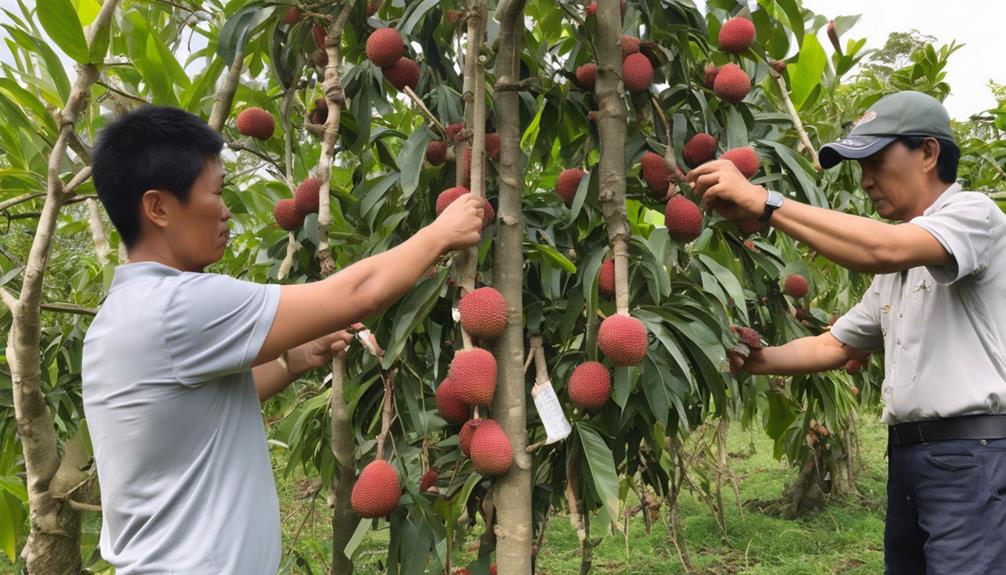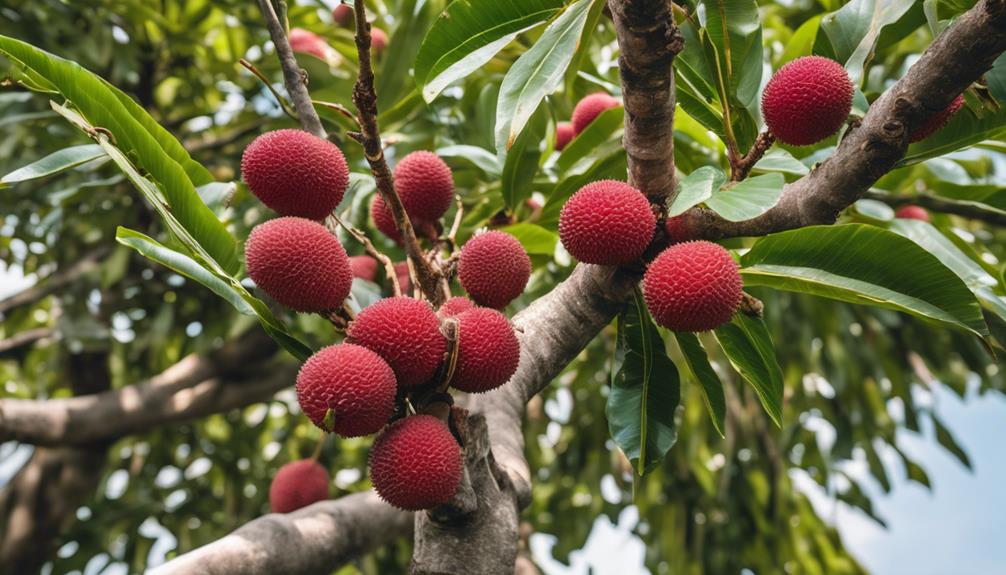When it comes to adjusting supports for your Lychee trees, understanding the intricacies of proper support techniques is key to ensuring their health and productivity. From timing adjustments to selecting the right support materials, each step plays an essential role in the overall success of your trees. By learning how to assess tree growth, install support structures effectively, and make necessary adjustments as the tree develops, you'll be equipped to facilitate ideal growth and stability. Stay tuned to discover the specific strategies that will help you master the art of supporting your Lychee trees.
Key Takeaways
- Adjust supports when heavy fruiting signs appear to prevent damage.
- Use sturdy metal stakes or bamboo poles for reliable support.
- Inspect existing supports for sturdiness and correct positioning.
- Securely fasten tree to stakes with soft ties for stability.
- Regularly monitor support effectiveness and make necessary adjustments.
Timing for Support Adjustment

Adjust the supports for your lychee trees when they begin to show signs of heavy fruiting to prevent damage and promote ideal growth. As the fruit starts to develop and the branches become weighed down, it's essential to provide adequate support to prevent any breakage or bending that could hinder the tree's health. By adjusting the supports at this stage, you're guaranteeing that your lychee tree can continue to thrive and produce high-quality fruit.
When you notice the branches starting to bow under the weight of the developing fruit, it's time to take action. Check the existing supports to make sure they're sturdy and positioned correctly to provide the necessary assistance. You may need to add additional stakes or ties to bolster the existing support system and prevent any potential damage.
Assessing Tree Growth
When evaluating tree growth in your lychee orchard, closely monitor the development of new branches and overall canopy expansion to guarantee peak health and productivity. Regularly inspect the height, thickness, and color of new branches to make sure they are growing steadily. Additionally, observe the spread of the canopy to confirm that it is reaching its desired size according to the variety of lychee you are cultivating. By evaluating these factors, you can detect any issues early on and take corrective measures promptly.
| Aspect | What to Look For | Action Needed |
|---|---|---|
| New Branches | Healthy growth, appropriate thickness | Prune if necessary |
| Canopy Expansion | Even spread, reaching desired size | Adjust support |
| Canopy Color | Vibrant green hue | Monitor nutrition |
Selecting Support Materials

Consider the strength and durability of the materials when selecting supports for your lychee trees. Opt for materials that can withstand the weight of the branches and the fruit without bending or breaking. Metal stakes or poles are commonly used due to their sturdy nature. They provide reliable support and are long-lasting, making them a great choice for ensuring the stability of your lychee trees.
Another suitable option is wooden stakes, which blend well with the natural surroundings of the tree. Make sure to choose hardwood stakes that are resilient against weather conditions and can bear the load effectively. Bamboo poles are also a viable choice as they're lightweight yet robust, providing adequate support for your lychee trees.
Avoid using weak or flimsy materials that may not hold up under the weight of the tree. Prioritize the strength and durability of the support materials to safeguard the growth and health of your lychee trees.
Installing Support Structures
Choose a suitable location for installing the support structures for your lychee trees to guarantee proper stability and growth.
When setting up the support structures, make sure they're placed securely in the ground to withstand the weight of the lychee tree and potential wind forces.
Begin by driving sturdy stakes into the ground at equal distances around the tree, ensuring they're deep enough to provide adequate support.
Use soft ties or straps to fasten the tree to the stakes gently, avoiding any damage to the tree trunk.
Additionally, consider installing crossbars between stakes for added stability, especially if your lychee tree is young or prone to swaying.
Regularly check the ties and stakes to confirm they're holding up well and make adjustments as needed.
Monitoring Support Effectiveness

To guarantee the stability and effectiveness of the support structures for your lychee tree, regularly assess their condition and make any necessary adjustments. Start by checking the ties, stakes, or trellises to confirm they're securely in place and supporting the tree adequately. Inspect for any signs of damage, such as loose ties or leaning stakes, which could compromise the support.
Monitor the growth of the tree and the weight of the branches to determine if the current support system is still sufficient.
Additionally, keep an eye on how the tree responds to weather conditions, especially during strong winds or heavy rainfall. If you notice any swaying or instability, it may be a sign that the supports need reinforcement. Make adjustments as needed, such as tightening ties, adding more stakes, or reinforcing the trellis to better support the tree.
Adjusting Support Angles
Check the support angles of your lychee tree to make sure they're properly adjusted for the best stability and growth. Important support angles are essential for guaranteeing that your tree grows in the right direction and remains sturdy.
Begin by examining the current angles of your supports. Make sure they aren't too steep or too shallow, as this can impact the tree's ability to stand upright and develop properly.
To adjust the angles, gently reposition the supports as needed. You may need to loosen the ties or stakes holding the tree in place to make the necessary adjustments.
Once you have altered the angles, secure the supports firmly to keep the tree in its new position. Remember to check the angles periodically as the tree grows to ensure that the supports continue to provide adequate stability.
Addressing Tree Expansion

Ensuring proper spacing between the branches and accommodating tree expansion with regular pruning are crucial for promoting natural growth. By regularly pruning your lychee tree, you can control its size and shape while encouraging healthy growth.
When addressing tree expansion, focus on removing any overcrowded or crossing branches. This will help improve air circulation and sunlight exposure, leading to better fruit production.
Pruning also aids in maintaining the structural integrity of the tree. As the tree expands, it's important to remove any weak or diseased branches to prevent potential hazards. Be sure to make clean cuts close to the branch collar to encourage proper healing and reduce the risk of infections.
Additionally, consider the overall shape of the tree when pruning to maintain a balanced structure. Encourage outward growth by trimming back inward-facing branches. This will help prevent overcrowding at the center of the tree and promote even distribution of fruit-bearing branches.
Ensuring Proper Stability
Maintaining the stability of your lychee tree is crucial for its overall health and productivity. To guarantee proper stability, start by inspecting the existing supports. Check for any signs of damage or weakness that could compromise the tree's balance. Reinforce or replace any unstable supports to prevent the tree from leaning or toppling over.
Additionally, consider the weight distribution of the tree. As the lychee tree grows and bears fruit, the branches may become heavier, affecting its stability. Prune the tree regularly to remove excess weight and promote a more balanced structure. This will reduce the risk of the tree swaying or breaking under its weight.
Furthermore, anchoring the base of the tree can greatly improve stability. Use stakes or anchors to secure the trunk to the ground, especially in areas prone to strong winds or storms. This extra support will help prevent the tree from tilting or uprooting during adverse weather conditions.
Conclusion
Now that you have adjusted the supports in your Lychee trees, you can sit back and enjoy watching them grow and thrive.
By regularly monitoring their growth, selecting the right support materials, and making necessary adjustments, you're ensuring that your trees stay healthy and produce delicious fruit.
Keep up the good work and continue to support your Lychee trees for a successful harvest!